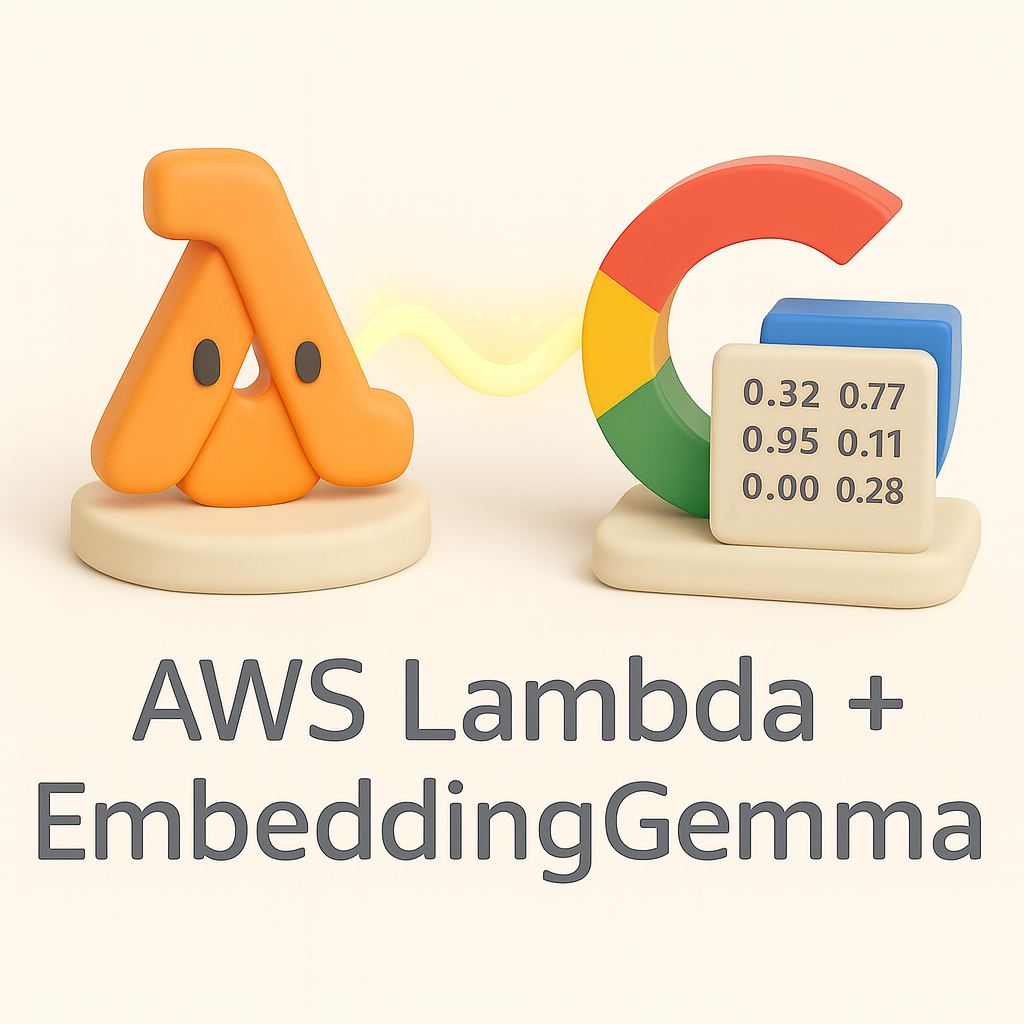Google's EmbeddingGemma on AWS Lambda - A Curiosity-Driven Experiment

Note: This is a curiosity-driven experiment, not a production recommendation. For real workloads, Amazon SageMaker is the right choice. This project explores what's possible when you push serverless boundaries.
1. The idea
After my BitNet Lambda experiment, I kept thinking: what about embeddings? I had text generation working on Lambda, but what about the other half of modern AI applications?
Google's EmbeddingGemma caught my attention—300M parameters, multilingual, designed for efficiency. Could it work on Lambda? Only one way to find out.
So I fired up Amazon Q Developer and started experimenting.
2. Why embeddings matter
Modern AI applications need both text generation and embeddings. RAG systems, semantic search, document processing—they all require this dual capability. I had the generation part working with BitNet, but what about embeddings?
EmbeddingGemma sits in a sweet spot: 300M parameters (~1.2GB) with multilingual support for 100+ languages. Unlike massive text generation models, embedding models are:
- Predictable: Fixed output dimensions (768 floats)
- Efficient: Single forward pass, no autoregressive generation
- Compact: Smaller memory footprint than multi-billion parameter LLMs
That efficiency profile makes "Lambda + Embeddings" the perfect complement to my BitNet experiment—completing the serverless AI toolkit.
3. The architecture
The architecture stayed simple: API Gateway triggers a Lambda function with 2GB memory. Inside lives a container image with transformers, sentence-transformers, and the complete EmbeddingGemma model. Lambda processes the text and returns a 768-dimensional vector.
Thanks to Amazon Q's help, I optimized the container to embed the entire model (~1.2GB) while keeping cold starts reasonable. No external model loading, no S3 downloads—everything lives in the container.
4. Amazon Q as co-pilot
Amazon Q CLI didn't just automate—it elevated the entire workflow. When I asked it to create a Dockerfile that could efficiently package transformers and the EmbeddingGemma model, it didn't just generate code—it explained why sentence-transformers was the right choice over raw transformers.
For infrastructure, Q generated a clean CDK stack targeting Lambda with ARM64 architecture and 2GB memory. When builds failed or performance lagged, Q helped interpret CloudWatch logs and suggested memory optimizations.
Having Claude Sonnet inside Q made this feel like pair programming with someone who actually understood ML deployment patterns.
5. Performance results
The numbers tell the story:
- Cold start: 12 seconds (not bad for a 300M model)
- Warm inference: 0.12-0.33 seconds per embedding
- Cost: ~$0.001 per request for short texts
- Memory sweet spot: 2GB (4GB+ shows no improvement)
Combined with BitNet for text generation, this setup creates a complete serverless AI toolkit that shines for:
- RAG systems: BitNet for generation, EmbeddingGemma for retrieval
- Semantic search: Document vectorization and similarity matching
- Prototype APIs: Quick AI services for testing and experimentation
It struggles with:
- Batch processing: Linear scaling kills economics
- Real-time chat: 12-second cold starts hurt UX
- High throughput: Concurrent requests need full memory allocation
6. The convergence
Two trends are colliding: models are getting more efficient while serverless platforms evolve. EmbeddingGemma represents the "efficient model" side—compact, purpose-built, and CPU-friendly.
On the platform side, we're seeing serverless runtimes optimize for AI workloads. When these trends meet—lightweight models and AI-aware serverless compute—deploying embeddings will be as casual as deploying a REST API.
7. Reality check
Let's be honest about the numbers:
Text length scaling:
- 10 characters: 0.32s
- 99 characters: 1.05s
- 588 characters: 4.06s
Memory efficiency:
- 2GB: Optimal performance
- 4GB+: No improvement, 2x cost
Infrastructure overhead: 0.7-0.8 seconds of the total latency is network + AWS API processing, not model inference.
8. Why not production
While technically successful, several factors make this unsuitable for serious workloads:
Economics don't scale: 2GB memory allocation for sporadic requests burns money. SageMaker's auto-scaling and GPU optimization provide better cost-per-embedding at volume.
Cold start penalty: 12-second delays kill user experience for interactive applications.
Better alternatives exist: Purpose-built ML infrastructure (SageMaker, ECS with GPUs) offers superior performance and economics for production embedding workloads.
9. The real value
This experiment's worth isn't in production deployment—it's about curiosity. What happens when you run Google's EmbeddingGemma in AWS Lambda? Can a 300M parameter embedding model really work in serverless compute? How does it perform?
Curiosity-driven insights: How EmbeddingGemma behaves in Lambda's constraints, memory optimization patterns for embedding models, and container packaging strategies you can only discover by trying.
Learning by doing: Understanding where EmbeddingGemma's efficiency meets Lambda's limitations, and where the serverless tax becomes prohibitive for ML workloads.
Future signals: As embedding models get more efficient and Lambda evolves, today's experiments with EmbeddingGemma become tomorrow's possibilities.
10. Wrapping up
Running Google's EmbeddingGemma on AWS Lambda isn't about beating dedicated ML infrastructure—it's about curiosity. What if you could deploy Google's embedding model as easily as a REST API? What would EmbeddingGemma's performance look like in Lambda? How much would it cost?
The question was simple: "What about embeddings on Lambda?" Sometimes the best experiments come from pure curiosity about what's possible when you combine Google's efficient embedding model with AWS's serverless compute.
The complete EmbeddingGemma-on-Lambda implementation is on GitHub. Clone it, try it, break it. See how far you can push EmbeddingGemma in Lambda before reaching for SageMaker.
And if you're curious about other Google models on AWS Lambda, let's chat about what other "impossible" combinations might be worth trying.
This project was built using vibe coding techniques with Amazon Q Developer, demonstrating how AI-assisted development can accelerate experimentation while maintaining architectural rigor.
